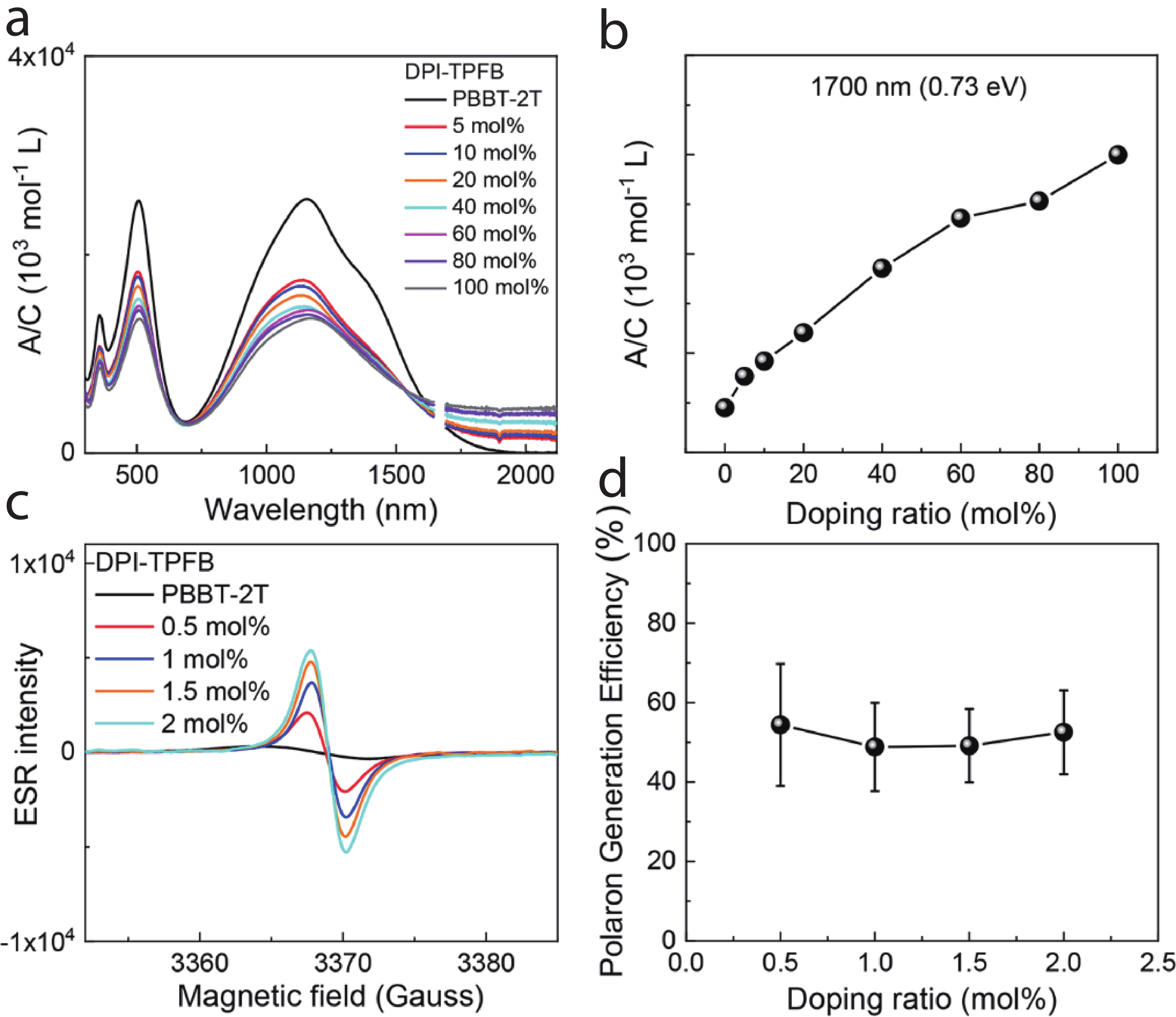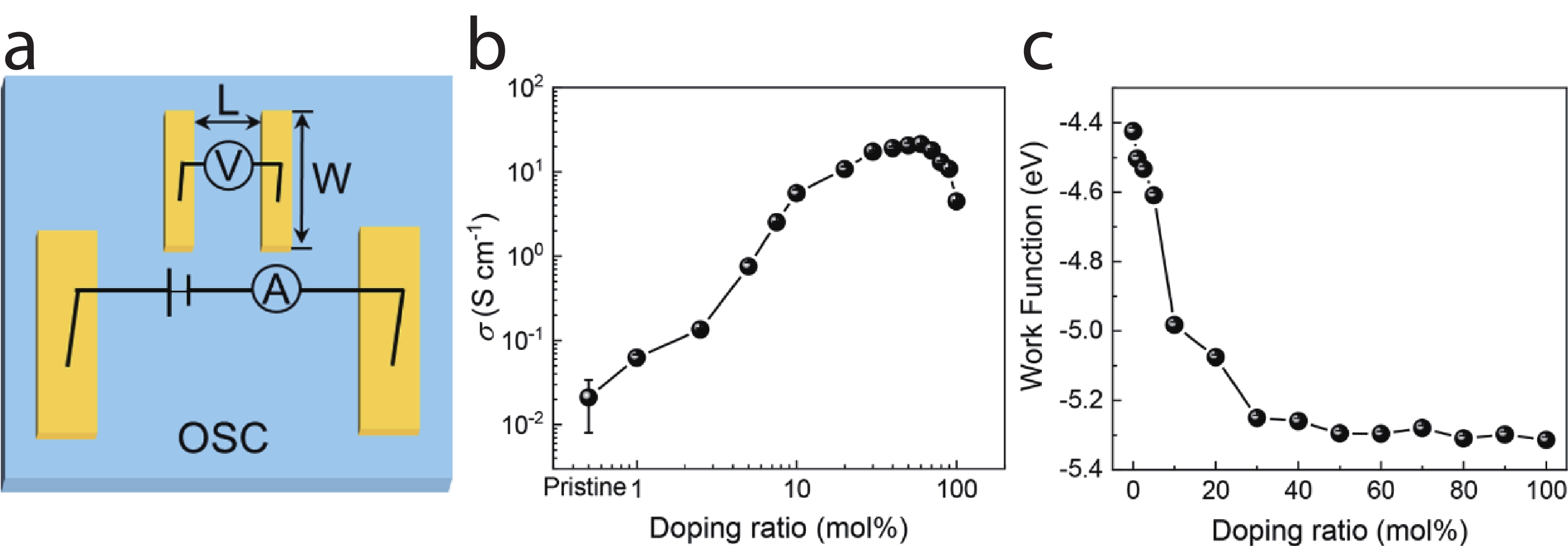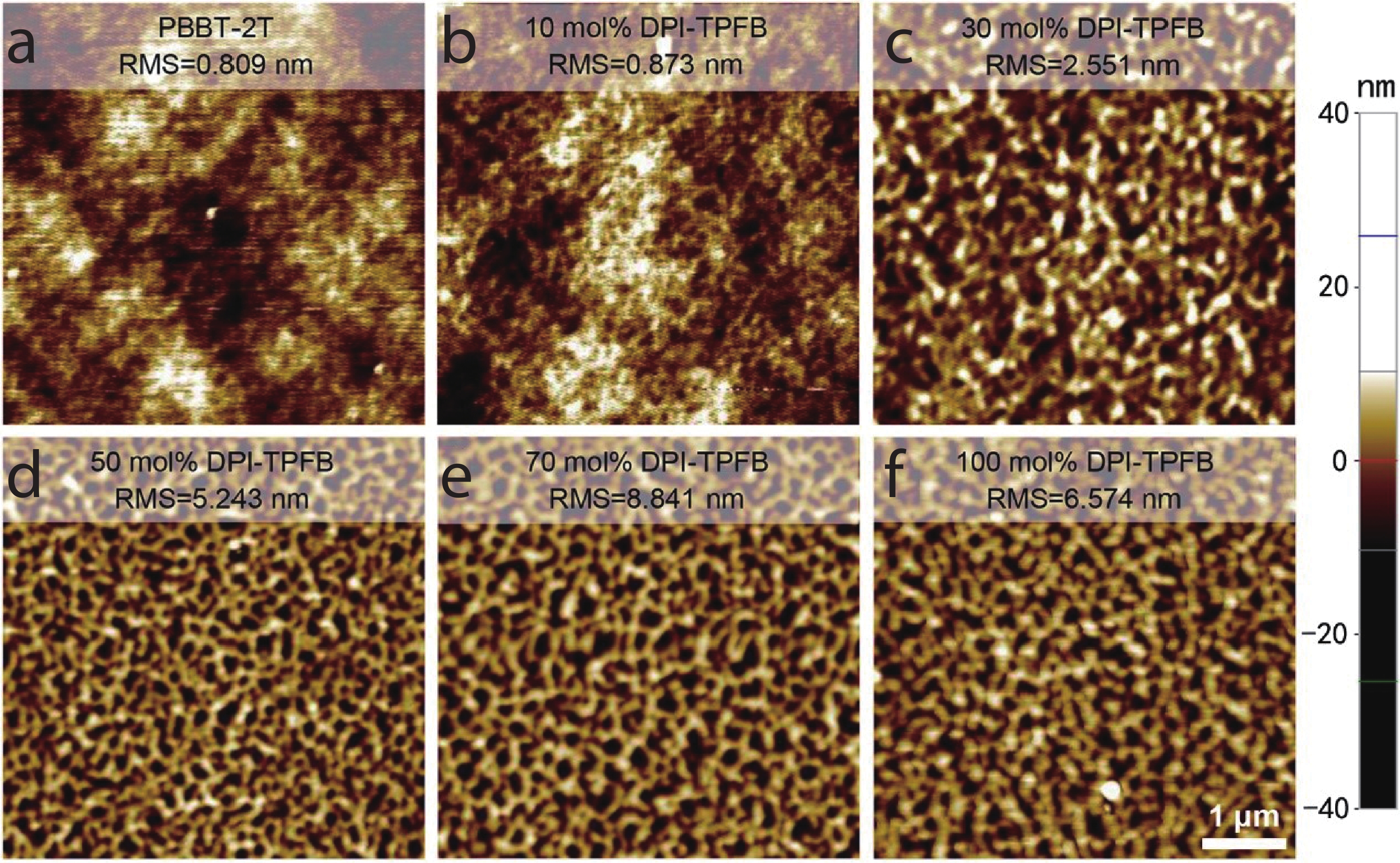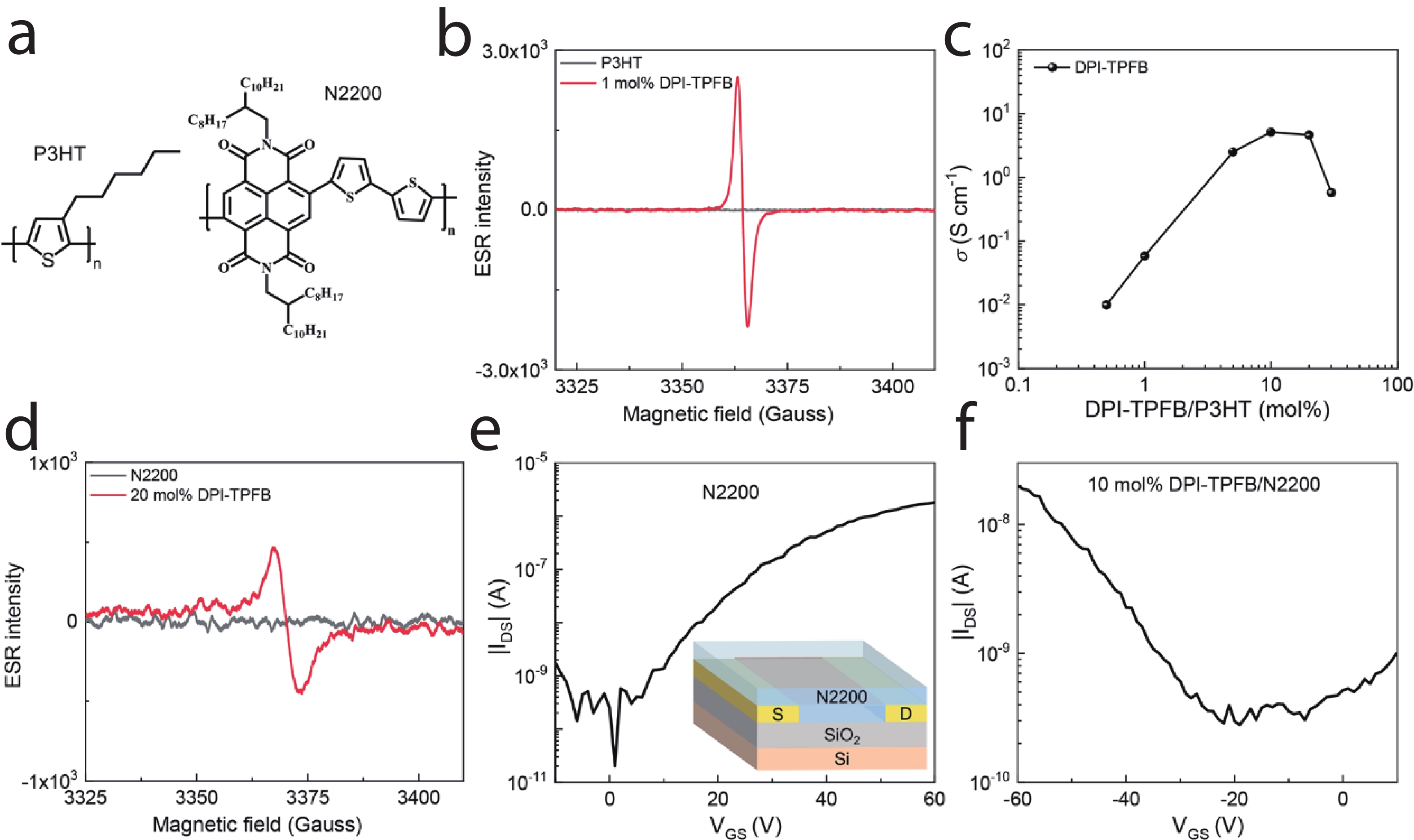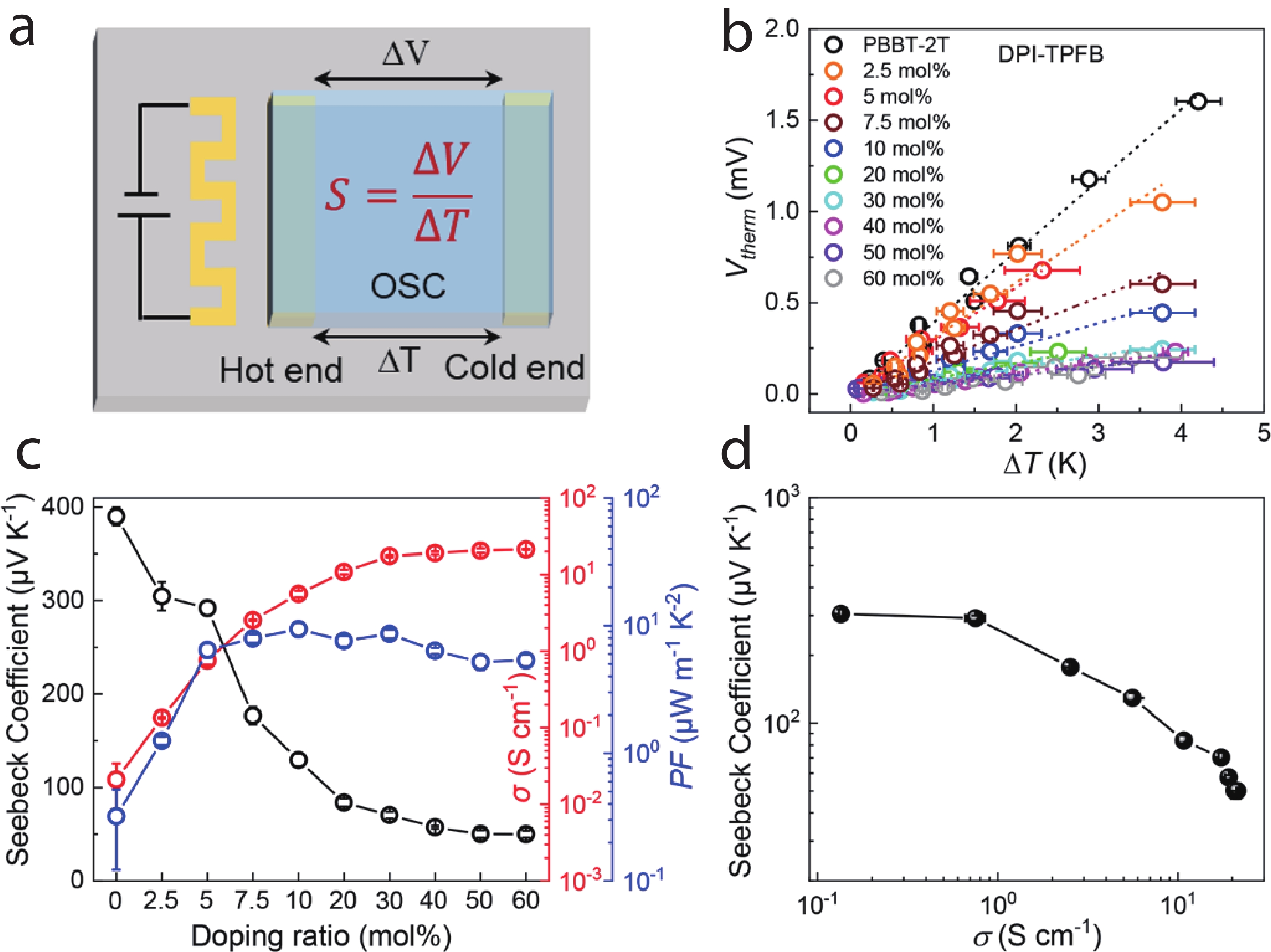| Citation: |
Jing Guo, Yaru Feng, Jinjun Zhang, Jing Zhang, Ping−An Chen, Huan Wei, Xincan Qiu, Yu Liu, Jiangnan Xia, Huajie Chen, Yugang Bai, Lang Jiang, Yuanyuan Hu. Investigating the doping performance of an ionic dopant for organic semiconductors and thermoelectric applications[J]. Journal of Semiconductors, 2025, 46(8): 082801. doi: 10.1088/1674-4926/25010027
****
J Guo, Y R Feng, J J Zhang, J Zhang, P A Chen, H Wei, X C Qiu, Y Liu, J N Xia, H J Chen, Y G Bai, L Jiang, and Y Y Hu, Investigating the doping performance of an ionic dopant for organic semiconductors and thermoelectric applications[J]. J. Semicond., 2025, 46(8), 082801 doi: 10.1088/1674-4926/25010027
|
Investigating the doping performance of an ionic dopant for organic semiconductors and thermoelectric applications
DOI: 10.1088/1674-4926/25010027
CSTR: 32376.14.1674-4926.25010027
More Information-
Abstract
Doping plays a pivotal role in enhancing the performance of organic semiconductors (OSCs) for advanced optoelectronic and thermoelectric applications. In this study, we systematically investigated the doping performance and applicability of the ionic dopant 4-isopropyl-4′-methyldiphenyliodonium tetrakis(penta-fluorophenyl-borate) (DPI-TPFB) as a p-dopant for OSCs. Using the p-type OSC PBBT-2T as a model system, we demonstrated that DPI-TPFB shows significant doping effect, as confirmed by ESR spectra, ultraviolet−visible−near-infrared (UV−vis−NIR) absorption, and work function analysis, and enhances the electronic conductivity of PBBT-2T films by over four orders of magnitude. Furthermore, DPI-TPFB exhibited broad doping applicability, effectively doping various p-type OSCs and even imparting p-type characteristics to the n-type OSC N2200, transforming its intrinsic n-type behavior into p-type. The application of DPI-TPFB-doped PBBT-2T films in organic thermoelectric devices (OTEs) was also explored, achieving a power factor of approximately 10 μW∙m−1∙K−2. These findings highlight the potential of DPI-TPFB as a versatile and efficient dopant for integration into organic optoelectronic and thermoelectric devices. -
References
[1] Chen P A, Guo J J, Yan X W, et al. A methodology of fabricating novel electrodes for semiconductor devices: Doping and van der waals integrating organic semiconductor films. Small, 2023, 19(27), e2207858 doi: 10.1002/smll.202207858[2] Simatos D, Nikolka M, Charmet J, et al. Electrolyte-gated organic field-effect transistors with high operational stability and lifetime in practical electrolytes. SmartMat, 2024, 5(6), e1291 doi: 10.1002/smm2.1291[3] Xie Y F, Ding C M, Jin Q Q, et al. Organic transistor-based integrated circuits for future smart life. SmartMat, 2024, 5(4), e1261 doi: 10.1002/smm2.1261[4] Zhang X, Zhao X T, Rao L M, et al. Solution-processed top-contact electrodes strategy for organic crystalline field-effect transistor arrays. Nano Res, 2022, 15(2), 858 doi: 10.1007/s12274-021-3563-0[5] Feng K, Yang W L , Jeong S Y, et al. Cyano-functionalized fused bithiophene imide dimer-based n-type polymers for high-performance organic thermoelectrics. Adv Mater, 2023, 35(31), e2210847 doi: 10.1002/adma.202210847[6] Kim J, Ju D, Kim S, et al. Disorder-controlled efficient doping of conjugated polymers for high-performance organic thermoelectrics. Adv Funct Mater, 2024, 34(6), 2309156 doi: 10.1002/adfm.202309156[7] Zhao Y, Liu L Y, Zhang F J, et al. Advances in organic thermoelectric materials and devices for smart applications. SmartMat, 2021, 2(4), 426 doi: 10.1002/smm2.1034[8] Xiong S X, Fukuda K, Nakano K, et al. Waterproof and ultraflexible organic photovoltaics with improved interface adhesion. Nat Commun, 2024, 15(1), 681 doi: 10.1038/s41467-024-44878-z[9] Guan S T, Li Y K, Xu C, et al. Self-assembled interlayer enables high-performance organic photovoltaics with power conversion efficiency exceeding 20. Adv Mater, 2024, 36(25), e2400342 doi: 10.1002/adma.202400342[10] Song A, Huang Q R, Zhang C Y, et al. Highly efficient organic solar cells with improved stability enabled by ternary copolymers with antioxidant side chains. J Semicond, 2023, 44(8), 082202 doi: 10.1088/1674-4926/44/8/082202[11] Stavrou K, Franca L G, Danos A, et al. Key requirements for ultraefficient sensitization in hyperfluorescence organic light-emitting diodes. Nat Photonics, 2024, 18, 554 doi: 10.1038/s41566-024-01395-1[12] Xing L J, Wang J H, Chen W C, et al. Highly efficient pure-blue organic light-emitting diodes based on rationally designed heterocyclic phenophosphazinine-containing emitters. Nat Commun, 2024, 15(1), 6175 doi: 10.1038/s41467-024-50370-5[13] Wan D R, Zhou J P, Meng G Y, et al. Peripheral carbazole units-decorated MR emitter containing B-N covalent bond for highly efficient green OLEDs with low roll-off. J Semicond, 2024, 45(8), 082402 doi: 10.1088/1674-4926/24040008[14] Zhang J, Guo J, Zhang H T, et al. Solution-processed monolayer molecular crystals: From precise preparation to advanced applications. Precis Chem, 2024, 2(8), 380 doi: 10.1021/prechem.3c00124[15] Zhang J, Lu X Q, Sun Y N, et al. Case study of metal coordination to the charge transport and thermal stability of porphyrin-based field-effect transistors. ACS Mater Lett, 2022, 4(4), 548 doi: 10.1021/acsmaterialslett.1c00844[16] Sun Y N, Shi X S, Yu Y M, et al. Low contact resistance organic single-crystal transistors with band-like transport based on 2, 6-bis-phenylethynyl-anthracene. Adv Sci, 2024, 11(22), e2400112 doi: 10.1002/advs.202400112[17] Wei H, Cheng Z H, Wu T, et al. Novel organic superbase dopants for ultraefficient N-doping of organic semiconductors. Adv Mater, 2023, 35(22), e2300084 doi: 10.1002/adma.202300084[18] Wei H, Chen P A, Guo J, et al. Low-cost nucleophilic organic bases as n-dopants for organic field-effect transistors and thermoelectric devices. Adv Funct Mater, 2021, 31(30), 2102768 doi: 10.1002/adfm.202102768[19] He L Z, Zhang L, Yang J L, et al. A covalent organic polymer containing dative nitrogen→boron bonds: Preparation, single-crystal structure, and photoresponse/photocatalytic performance. Small Struct, 2024, 2400492 doi: 10.1002/sstr.202400492[20] Wang L, Sun T R, Zhao X L, et al. Electrophilic-attack doped organic field-effect transistors for ultrasensitive and selective hydrogen sulfide detection. ACS Appl Mater Interfaces, 2024, 16(49), 68103 doi: 10.1021/acsami.4c15971[21] Chen P A, Guo J, Wei H, et al. Achieving unipolar organic transistors for complementary circuits by selective usage of doped organic semiconductor film electrodes. Adv Funct Mater, 2025, 35(3), 2413880 doi: 10.1002/adfm.202413880[22] Zhu X T, Luo X, Deng Y Z, et al. Doping bilayer hole-transport polymer strategy stabilizing solution-processed green quantum-dot light-emitting diodes. Sci Adv, 2024, 10(33), eado0614 doi: 10.1126/sciadv.ado0614[23] Guo J, Chen P A, Yang S Z, et al. Dopant-induced morphology of organic semiconductors resulting in high doping performance. Small Methods, 2025, 9(1), 2400084 doi: 10.1002/smtd.202400084[24] Guo J, Liu Y, Chen P A, et al. Revealing the electrophilic-attack doping mechanism for efficient and universal p-doping of organic semiconductors. Adv Sci, 2022, 9(32), e2203111 doi: 10.1002/advs.202203111[25] Guo J, Li G D, Reith H, et al. Doping high-mobility donor-acceptor copolymer semiconductors with an organic salt for high-performance thermoelectric materials. Adv Elect Mater, 2020, 6(3), 1900945 doi: 10.1002/aelm.201900945[26] Hu Y Y, Rengert Z D, McDowell C, et al. Doping polymer semiconductors by organic salts: Toward high-performance solution-processed organic field-effect transistors. ACS Nano, 2018, 12(4), 3938 doi: 10.1021/acsnano.8b01460[27] Ke Z F, Ahmed M H, Abtahi A, et al. Thermally activated aromatic ionic dopants (TA-AIDs) enabling stable doping, orthogonal processing and direct patterning. Adv Funct Mater, 2023, 33(8), 2211522 doi: 10.1002/adfm.202211522[28] Zheng X P, Liu J, Liu T, et al. Photoactivated p-doping of organic interlayer enables efficient perovskite/silicon tandem solar cells. ACS Energy Lett, 2022, 7(6), 1987 doi: 10.1021/acsenergylett.2c00780[29] Zhang H J, Hui W, Wang Z, et al. Ultraviolet-light induced H+ doping in polymer hole transport material for highly efficient perovskite solar cells. Mater Today Energy, 2022, 30, 101159 doi: 10.1016/j.mtener.2022.101159[30] Hu M M, Risqi A M, Wu J C, et al. Highly stable n–i–p structured formamidinium tin triiodide solar cells through the stabilization of surface Sn2+ cations. Adv Funct Mater, 2023, 33(29), 2300693 doi: 10.1002/adfm.202300693[31] Risqi A M, Hu M M, Chen L, et al. Highly stable and efficient N-I-P structured tin-rich lead-tin halide perovskite solar cells with blended hole-transporting materials. Adv Energy Mater, 2025, 15(8), 2403033 doi: 10.1002/aenm.202403033[32] Privitera A, Warren R, Londi G, et al. Electron spin as fingerprint for charge generation and transport in doped organic semiconductors. J Mater Chem C, 2021, 9(8), 2944 doi: 10.1039/D0TC06097F[33] Yee P Y, Tyler Scholes D, Schwartz B J, et al. Dopant-induced ordering of amorphous regions in regiorandom P3HT. J Phys Chem Lett, 2019, 10(17), 4929 doi: 10.1021/acs.jpclett.9b02070[34] Suh E H, Oh J G, Jung J, et al. Brønsted acid doping of P3HT with largely soluble tris(pentafluorophenyl)borane for highly conductive and stable organic thermoelectrics via one-step solution mixing. Adv Energy Mater, 2020, 10(47), 2002521 doi: 10.1002/aenm.202002521[35] Marqués P S, Londi G, Yurash B, et al. Understanding how lewis acids dope organic semiconductors: A "complex" story. Chem Sci, 2021, 12(20), 7012 doi: 10.1039/D1SC01268A[36] Tang J H, Ji J J, Chen R S, et al. Achieving efficient p-type organic thermoelectrics by modulation of acceptor unit in photovoltaic π-conjugated copolymers. Adv Sci, 2022, 9(4), 2103646 doi: 10.1002/advs.202103646[37] Chen C, Jacobs I E, Kang K, et al. Observation of weak counterion size dependence of thermoelectric transport in ion exchange doped conducting polymers across a wide range of conductivities. Adv Energy Mater, 2023, 13(9), 2202797 doi: 10.1002/aenm.202202797 -
Proportional views





 Jing Guo is a lecturer at the School of Physics and Information Engineering, Shanxi Normal University, located in China. He obtained his Ph.D. from the School of Physics and Microelectronics Science, Hunan University in 2022. His current research focuses on electronic devices and applications based on organic semiconductors.
Jing Guo is a lecturer at the School of Physics and Information Engineering, Shanxi Normal University, located in China. He obtained his Ph.D. from the School of Physics and Microelectronics Science, Hunan University in 2022. His current research focuses on electronic devices and applications based on organic semiconductors. Lang Jiang is a Professor at Hebei University of Technology in China. Lang Jiang received his BS degree in Applied Physics from the School of Physics and Microelectronics Science, Hunan University in 2004 and his PhD degree from ICCAS in 2011. Then he became an Assistant Professor in ICCAS. He worked as a postdoctoral in Cavendish Laboratory, University of Cambridge in 2013. His current research focuses on molecular electronics including crystalline organic semiconductors and device engineering and their circuit applications.
Lang Jiang is a Professor at Hebei University of Technology in China. Lang Jiang received his BS degree in Applied Physics from the School of Physics and Microelectronics Science, Hunan University in 2004 and his PhD degree from ICCAS in 2011. Then he became an Assistant Professor in ICCAS. He worked as a postdoctoral in Cavendish Laboratory, University of Cambridge in 2013. His current research focuses on molecular electronics including crystalline organic semiconductors and device engineering and their circuit applications. Yuanyuan Hu is a professor at Hunan University in China. He received his BS from Nanjing University in 2008 and his PhD from the University of Cambridge in 2015. He was a postdoctoral fellow at the University of California, Santa Barbara between 2015 and 2017. His current research is on fabrication, characterization and mechanism studies of electronic and photonic devices based on solution-processable semiconductors.
Yuanyuan Hu is a professor at Hunan University in China. He received his BS from Nanjing University in 2008 and his PhD from the University of Cambridge in 2015. He was a postdoctoral fellow at the University of California, Santa Barbara between 2015 and 2017. His current research is on fabrication, characterization and mechanism studies of electronic and photonic devices based on solution-processable semiconductors.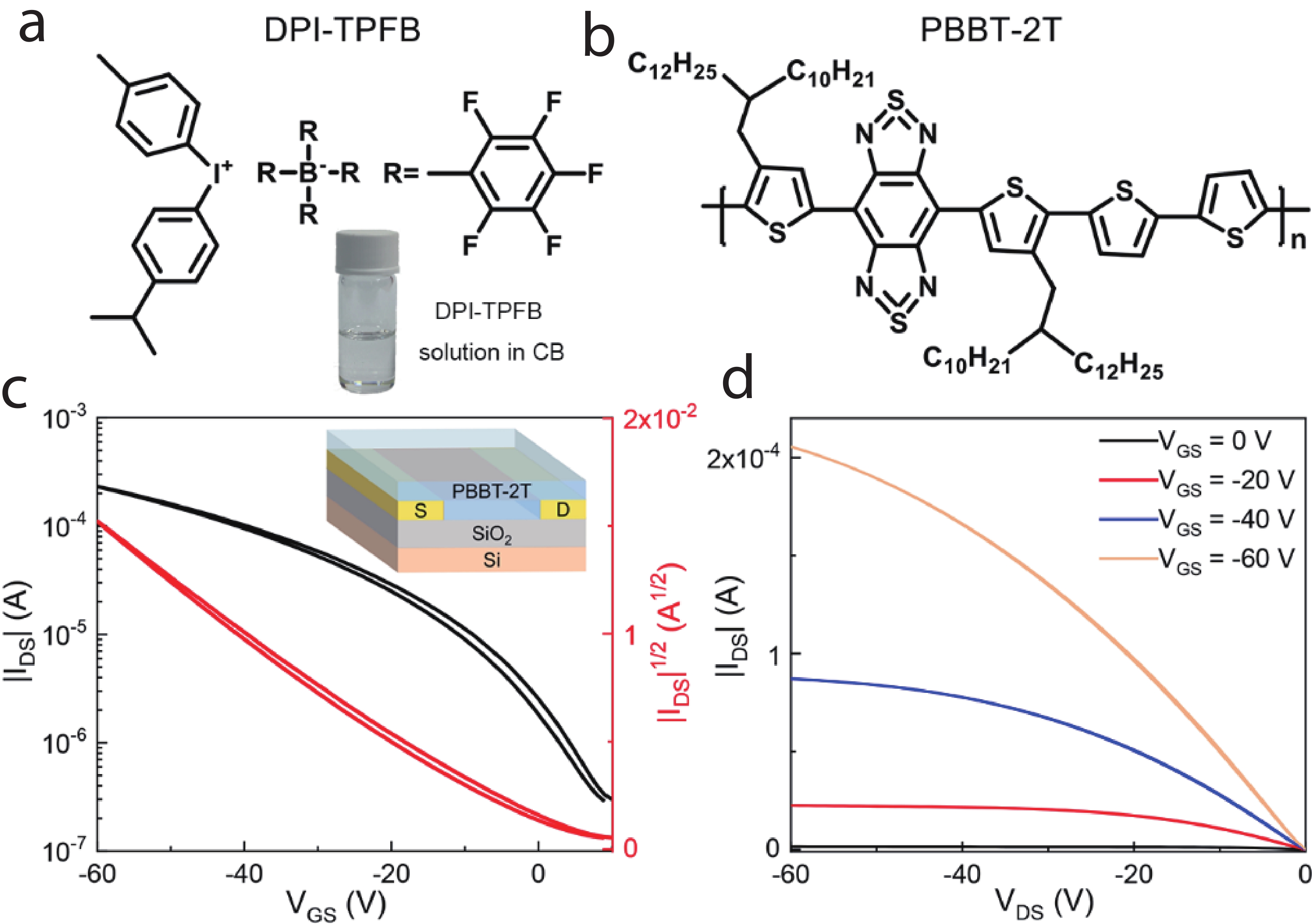
 DownLoad:
DownLoad:
